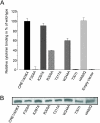Evolutionary proteomics identifies amino acids essential for ligand-binding of the cytokinin receptor CHASE domain
- PMID: 17439640
- PMCID: PMC1863423
- DOI: 10.1186/1471-2148-7-62
Evolutionary proteomics identifies amino acids essential for ligand-binding of the cytokinin receptor CHASE domain
Abstract
Background: In plants the hormone cytokinin is perceived by members of a small cytokinin receptor family, which are hybrid sensor histidine kinases. While the immediate downstream signaling pathway is well characterized, the domain of the receptor responsible for ligand binding and which residues are involved in this process has not been determined experimentally.
Results: Using a live cell hormone-binding assay, we show that cytokinin is bound by a receptor domain predicted to be extracellular, the so called CHASE (cyclases, histidine kinase associated sensory extracellular) domain. The CHASE domain occurs not only in plant cytokinin receptors but also in numerous orphan receptors in lower eukaryotes and bacteria. Taking advantage of this fact, we used an evolutionary proteomics approach to identify amino acids important for cytokinin binding by looking for residues conserved in cytokinin receptors, but not in other receptors. By comparing differences in evolutionary rates, we predicted five amino acids within the plant CHASE domains to be crucial for cytokinin binding. Mutagenesis of the predicted sites and subsequent binding assays confirmed the relevance of four of the selected amino acids, showing the biological significance of site-specific evolutionary rate differences.
Conclusion: This work demonstrates the use of a bioinformatic analysis to mine the huge set of genomic data from different taxa in order to generate a testable hypothesis. We verified the hypothesis experimentally and identified four amino acids which are to a different degree required for ligand-binding of a plant hormone receptor.
Figures




Similar articles
-
Structural basis for cytokinin receptor signaling: an evolutionary approach.Plant Cell Rep. 2013 Jun;32(6):781-93. doi: 10.1007/s00299-013-1408-3. Epub 2013 Mar 23. Plant Cell Rep. 2013. PMID: 23525743 Review.
-
The CHASE domain: a predicted ligand-binding module in plant cytokinin receptors and other eukaryotic and bacterial receptors.Trends Biochem Sci. 2001 Oct;26(10):579-82. doi: 10.1016/s0968-0004(01)01968-5. Trends Biochem Sci. 2001. PMID: 11590000
-
The specificity of cytokinin signalling in Arabidopsis thaliana is mediated by differing ligand affinities and expression profiles of the receptors.Plant J. 2011 Jul;67(1):157-68. doi: 10.1111/j.1365-313X.2011.04584.x. Epub 2011 May 9. Plant J. 2011. PMID: 21426428
-
Structure prediction, evolution and ligand interaction of CHASE domain.FEBS Lett. 2004 Oct 22;576(3):287-90. doi: 10.1016/j.febslet.2004.09.020. FEBS Lett. 2004. PMID: 15498549
-
Plant hormone binding sites.Ann Bot. 2004 Mar;93(3):227-33. doi: 10.1093/aob/mch041. Ann Bot. 2004. PMID: 14988095 Free PMC article. Review.
Cited by
-
The Role of Cytokinins during the Development of Strawberry Flowers and Receptacles.Plants (Basel). 2023 Oct 25;12(21):3672. doi: 10.3390/plants12213672. Plants (Basel). 2023. PMID: 37960026 Free PMC article.
-
Structural basis for cytokinin receptor signaling: an evolutionary approach.Plant Cell Rep. 2013 Jun;32(6):781-93. doi: 10.1007/s00299-013-1408-3. Epub 2013 Mar 23. Plant Cell Rep. 2013. PMID: 23525743 Review.
-
Two-component signaling elements and histidyl-aspartyl phosphorelays.Arabidopsis Book. 2008;6:e0112. doi: 10.1199/tab.0112. Epub 2008 Jul 14. Arabidopsis Book. 2008. PMID: 22303237 Free PMC article.
-
Advances in upstream players of cytokinin phosphorelay: receptors and histidine phosphotransfer proteins.Plant Cell Rep. 2012 May;31(5):789-99. doi: 10.1007/s00299-012-1229-9. Epub 2012 Feb 15. Plant Cell Rep. 2012. PMID: 22350315 Review.
-
Characterization of five CHASE-containing histidine kinase receptors from Populus × canadensis cv. Robusta sensing isoprenoid and aromatic cytokinins.Planta. 2019 Nov 27;251(1):1. doi: 10.1007/s00425-019-03297-x. Planta. 2019. PMID: 31776777
References
Publication types
MeSH terms
Substances
LinkOut - more resources
Full Text Sources
Other Literature Sources

